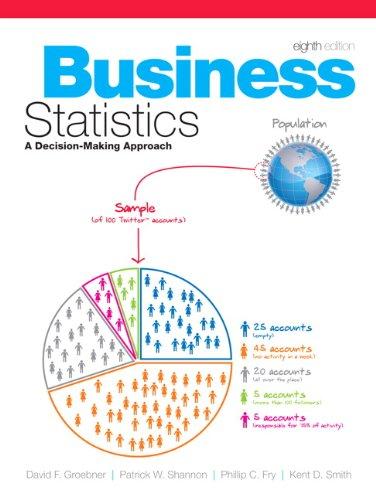Most major airlines allow passengers to carry two pieces of luggage (of a certain maximum size) onto
Question:
Most major airlines allow passengers to carry two pieces of luggage (of a certain maximum size) onto the plane. However, their studies show that the more carry-on baggage passengers have, the longer it takes to unload and load passengers. One regional airline is considering changing its policy to allow only one carry-on per passenger. Before doing so, it decided to collect some data. Specifically, a random sample of 1,000 passengers was selected. The passengers were observed, and the number of bags carried on the plane was noted. Out of the 1,000 passengers, 345 had more than one bag.
a. Based on this sample, develop and interpret a 95%
confidence interval estimate for the proportion of the traveling population that would have been impacted had the one-bag limit been in effect.
Discuss your result.
b. The domestic version of Boeing’s 747 has a capacity for 568 passengers. Determine an interval estimate of the number of passengers that you would expect to carry more than one piece of luggage on the plane. Assume the plane is at its passenger capacity.
c. Suppose the airline also noted whether the passenger was male or female. Out of the 1,000 passengers observed, 690 were males. Of this group, 280 had more than one bag. Using this data, obtain and interpret a 95% confidence interval estimate for the proportion of male passengers in the population who would have been affected by the one-bag limit.
Discuss.
d. Suppose the airline decides to conduct a survey of its customers to determine their opinion of the proposed one-bag limit. The plan calls for a random sample of customers on different flights to be given a short written survey to complete during the flight. One key question on the survey will be: “Do you approve of limiting the number of carry-on bags to a maximum of one bag?” Airline managers expect that only about 15% will say
“yes.” Based on this assumption, what size sample should the airline take if it wants to develop a 95% confidence interval estimate for the population proportion who will say “yes” with a margin of error of 0.02?
Step by Step Answer:

Business Statistics A Decision Making Approach
ISBN: 9780136121015
8th Edition
Authors: David F. Groebner, Patrick W. Shannon, Phillip C. Fry, Kent D. Smith






